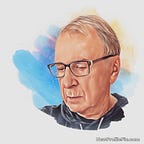Walking the Hall to Wellness: A Therapist’s Tale
She follows me down the hall. I can feel her eyes watching my every movement. I tread carefully, plant the heel, rock forward, and step off on the toe. Then, step by step, I do the same on the other side, heading for the open door.
I wear a tan sports coat, black pants, a paisley blue shirt, and blue suede shoes. Entering the door, I place the jacket and shirt on a hanger and turn to face her.
“Take off your shirt,” she says. “I want to see your back.”
I comply, pulling the black tee over my head.
“Lie face down, and we will get started,” she says.
I’m on the table, starting some small talk.
“What’s been going on today? You’re normally in your gym clothes,” she asks.
“It’s been a busy day, meeting on top of meeting,” I answer.
“Yes, I can see you’re a bit tight.”
She names a muscle and applies pressure. I grit my teeth, absorbing the local pain.
She explains the procedure, moving in a careful sequence to uncover the effect of my stressful day and the other days when bending over a computer was my normal pose.
“You have such a keen sense of observation,” I say. “You see the complex movement of my body and muscles and use pattern recognition and your vast knowledge to know what to do.”
“Yes, first you have to get the overall picture, then fit in all the small indicators of what is going on, the movement, the coordination, the hesitations, the affect…,” she says.
“I’m not sure everyone has that skill. What do you think?” I ask.
“Experience counts. Of course, we’re trained to observe and diagnose, but some are better than others.”
Football quarterbacks, strategic planners, landscape designers, editors, CEOs, and many other roles require good pattern recognition and the ability to sense multiple signals and images and then size and interpret them. And after that interpretation, talented people decide what action to take. Pattern recognition is the foundation of diagnosis, the critical step before a doctor, CEO, or skilled worker decides what to do.
Can pattern recognition be taught? Indeed, education and experience are essential for the skill, but why are some people so good at it and others so mediocre? That question will require more research, but I’m fascinated to find out. It’s on my to-do list.
Megan Braverman is my physical therapist and has exceptional pattern recognition. She and a colleague, Rebecca Brown, helped me recover from a hip replacement years ago. The hip is operating normally, but aging and other effects keep me going back for more care. Megan designed my exercise program and is an essential advisor in my healthcare program. Her treatments are aimed at the body, but they also accentuate a positive mental state. I’m fortunate to have this gift of care.
